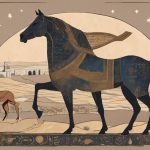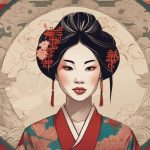As you explore the rich cultural heritage of Australian Aboriginal Songlines, you'll uncover a vibrant oral tradition woven from poetry, song, and dance. Songlines, the ancient pathways of ancestral beings, shape the cultural identity of Aboriginal people. Passed down through generations, these complex networks of stories, songs, and dances weave together to form a poetic tapestry. Ancestral beings' creative powers extend to governance and law, carrying cultural knowledge, traditions, and history. As you uncover more, you'll discover how Songlines have inspired modern Australian art, sparked cultural renaissance, and continue to captivate audiences, guiding future generations and celebrating Indigenous identity.
Origins of Songlines and Dreamtime
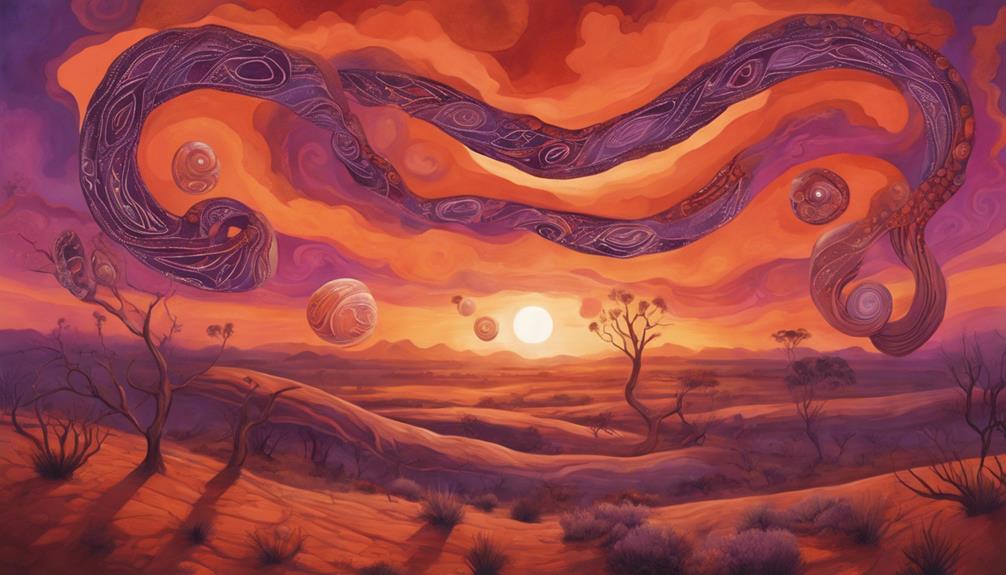
Exploring the rich cultural heritage of Australian Aboriginal people, you'll uncover that Songlines and Dreamtime are closely connected, with the origins of Songlines tracing back to the ancestral beings that roamed the land during the Dreamtime, a complex network of stories, songs, and dances that crisscross the Australian landscape. This intricate web of ancient wisdom has been passed down through generations, shaping the cultural identity of Aboriginal people. As you dig deeper into the Dreamtime, you'll discover that it's a domain where myth and reality blend, where ancestral beings created the world and its features through their journeys. The Songlines, which are believed to hold the secrets of creation, are an integral part of this narrative, weaving together the history, culture, and spirituality of Aboriginal people. By understanding the origins of Songlines and Dreamtime, you'll gain insight into the rich cultural heritage of Australian Aboriginal people, and appreciate the significance of these ancient stories in shaping their cultural identity.
Weaving Myths and Ancestral Beings
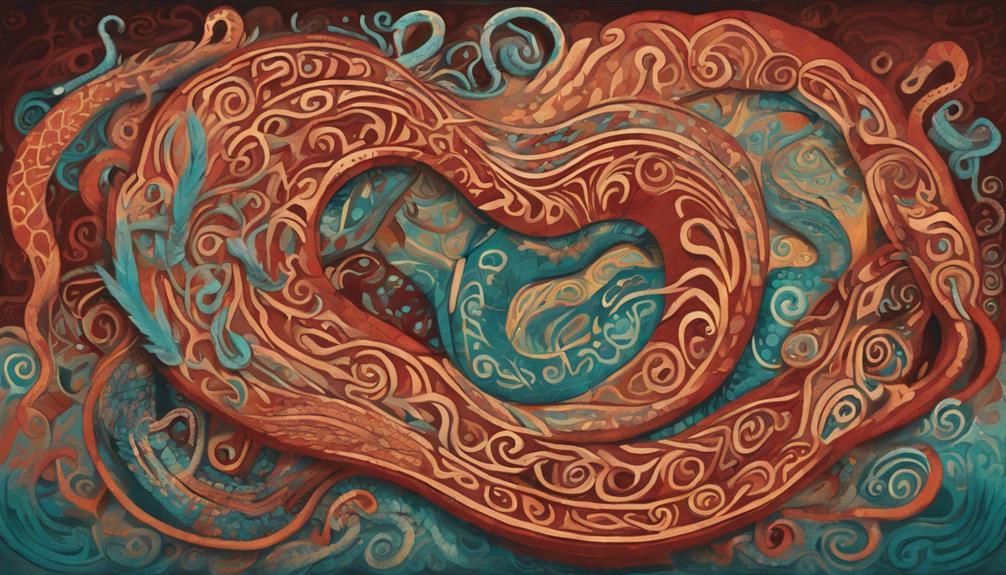
As you explore the intricate narrative of Songlines, you'll find that ancestral beings, imbued with extraordinary powers, wove myths that brought the Australian landscape to life. These ancestral beings traversed the land, creating rivers, mountains, and valleys as they traveled. Their journeys created Songlines, which are imbued with ancestral echoes that resonate through the land. The myths they wove are rich in symbolism, carrying the essence of the land and the people. The ancestral beings' creative powers are echoed in the cosmic harmonies that resonate through the Songlines. These harmonies are not just musical, but also spiritual, connecting the people to the land and the Dreamtime. As you explore further into the narrative, you'll discover that the ancestral beings' extraordinary powers are not limited to creation, but also extend to governance, law, and social order. The myths they created are not just entertaining stories, but rather, they carry the weight of cultural knowledge, traditions, and history.
Songlines as Geographic Maps
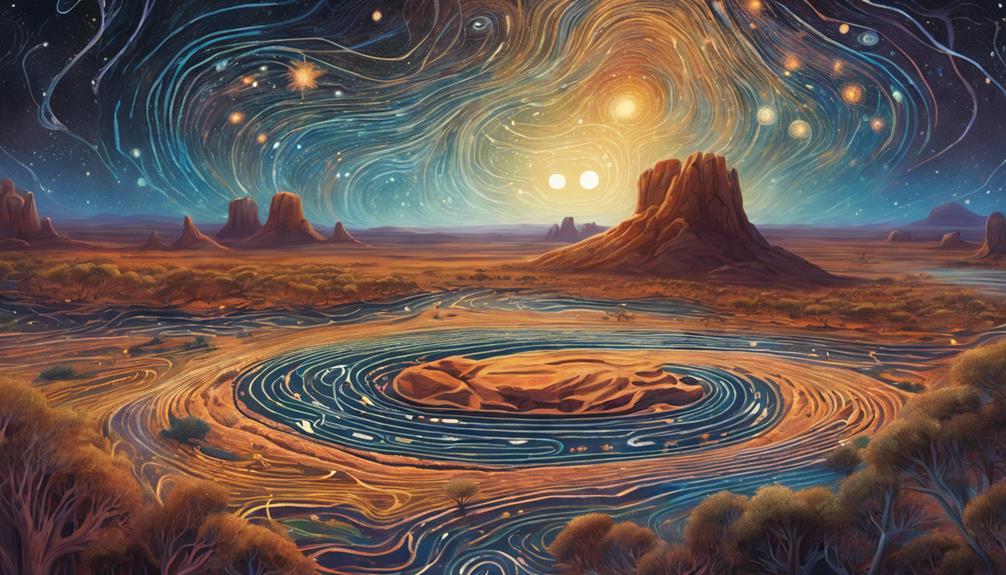
Through the lens of Songlines, you can explore the Australian landscape as if it were a vast, intricately woven tapestry, with every rock, river, and mountain serving as a geographic marker that echoes the ancestral beings' creative journeys. This ancient cartography is embedded in the Songlines, which serve as a musical guide, leading you through the land. Each Songline is a melodic pathway that weaves together the physical and spiritual domains, creating a complex network of stories, songs, and dances that crisscross the Australian continent. As you follow a Songline, you're not just traversing physical space; you're also journeying through the ancestral narratives that shaped the land. The Songlines chart the creative journeys of the ancestral beings, who sang the land into existence, creating rivers, mountains, and valleys as they traveled. By following these musical pathways, you're not just exploring the land; you're also honoring the ancestral beings' creative power.
Cultural Significance of Storytelling

One of the most profound aspects of Australian Aboriginal culture is the way storytelling serves as an essential thread that weaves together individual and collective identities, fostering a deep sense of community and shared history. As you explore the world of Aboriginal storytelling, you'll discover that it's not just about sharing entertaining tales, but about conveying essential information, values, and wisdom. Storytelling is an integral part of community engagement, where Elders share their knowledge with younger generations, preserving the cultural heritage of their people. This intergenerational knowledge transfer is critical, as it guarantees the continuation of traditions, customs, and beliefs. Through storytelling, Aboriginal people can connect with their ancestors, honor their history, and pass on valuable lessons to their children. By engaging with these stories, you'll gain a deeper understanding of the intricate relationships between the land, the people, and their ancestors. By doing so, you'll appreciate the profound cultural significance of storytelling in Australian Aboriginal culture.
Poetic Devices in Oral Tradition

You'll find that Aboriginal storytelling is rich in poetic devices, which serve to enrich the narrative, evoke emotions, and convey complex ideas, ultimately ensuring the survival of cultural knowledge in the oral tradition. One such device is rhythmic repetition, where phrases or words are repeated to create a sense of rhythm, emphasizing important themes or messages. This technique helps to engage the listener, making the story more memorable and facilitating the transmission of cultural knowledge.
Another essential poetic device is sonic symbolism, where sounds and rhythms evoke specific emotions or convey particular meanings. For instance, the didgeridoo's distinctive sound can evoke the sounds of nature, while the clapsticks' rhythmic beat can signal the pulse of life. These sonic symbols add depth and complexity to the narrative, allowing the storyteller to convey subtle nuances and emotions. By incorporating these poetic devices, Aboriginal storytellers create a rich tapestry of meaning, weaving together words, sounds, and rhythms to convey the essence of their culture.
Songlines and Ritual Practices
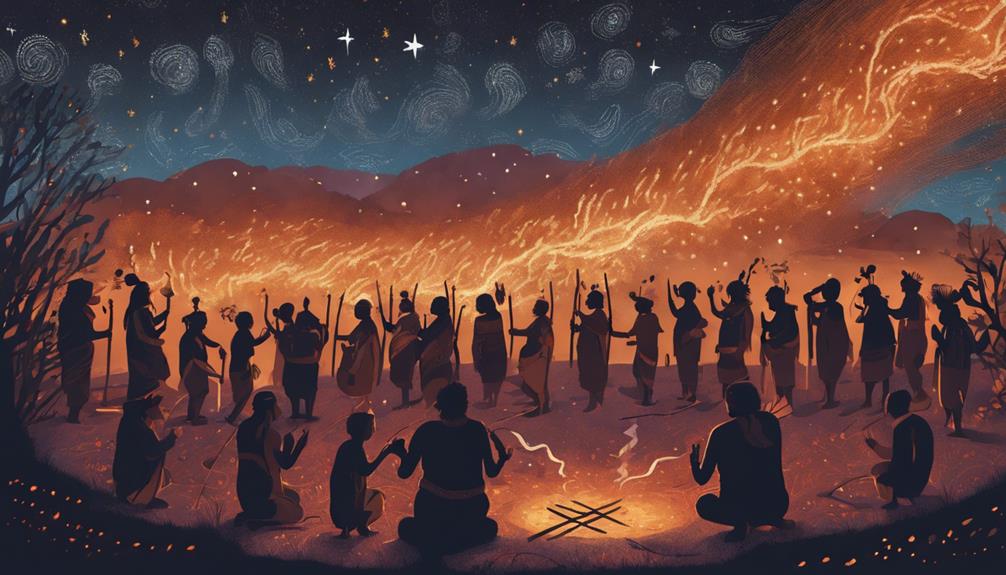
In Aboriginal culture, your journey along the songlines, ancestral pathways that crisscross the land, is deeply intertwined with ritual practices that evoke the Dreamtime, a domain where the past, present, and future converge. As you walk these sacred paths, you're not just traversing the physical landscape, but also exploring the spiritual domain. Rite performances, such as initiation ceremonies and rituals, are an integral part of this journey. These performances often take place in Sacred landscapes, where the land itself is imbued with ancestral power. The songs, dances, and stories that accompany these rites serve to awaken the Dreamtime, allowing participants to connect with the ancestral beings that shaped the land. Through these rituals, you're not just honoring the ancestors, but also reaffirming your connection to the land and your place within the broader cosmology. As you participate in these rituals, you become an active participant in the ongoing creation of the world, weaving your own story into the fabric of the songlines.
Preserving Songlines for Future
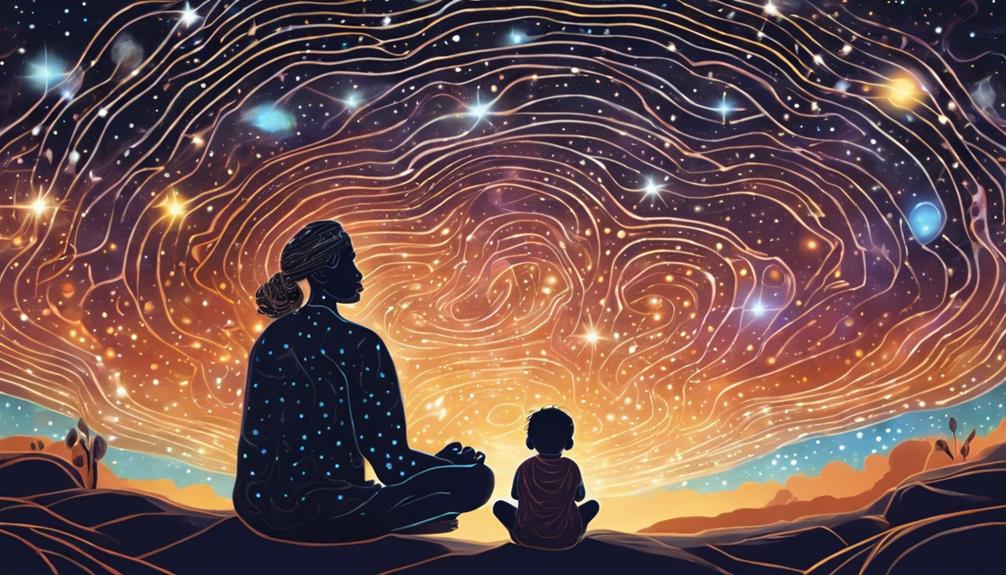
As you've woven your story into the fabric of the songlines, you're now entrusted with the responsibility of preserving these ancestral pathways for future generations. The weight of this task cannot be overstated, as the songlines hold the very essence of Aboriginal identity and culture. To guarantee their survival, it's essential to adopt a multifaceted approach that combines traditional practices with modern innovations.
One such innovation is the creation of digital archives, where songlines can be recorded, transcribed, and stored for posterity. These archives not only provide a safeguard against cultural loss but also facilitate access for future generations to learn from and engage with their heritage. Community engagement is also crucial, as it fosters a sense of ownership and responsibility among community members to preserve and pass on their songlines. By empowering local communities to take an active role in preservation efforts, we can ensure the long-term viability of these ancient traditions. Through a combination of digital archives and community engagement, we can safeguard the integrity of the songlines, allowing them to continue inspiring and guiding future generations.
Songlines in Modern Australian Culture

The exploration of interest in Australian Aboriginal songlines has sparked a cultural renaissance, with modern Australian artists, musicians, and writers drawing inspiration from these ancient stories to create innovative works that resonate with contemporary audiences. As you immerse yourself in the world of modern Australian culture, you'll notice that songlines have become a powerful symbol of Indigenous identity. Contemporary artists are reimagining these ancient narratives, infusing them with contemporary relevance and vitality. You'll find songlines woven into various art forms, from vibrant visual artworks to soulful music and poignant literature. This cultural resurgence is not only a validation of the enduring power of songlines but also a celebration of Indigenous identity. By embracing these ancient stories, modern Australian artists are able to tap into the rich cultural heritage of the land, creating works that are both deeply rooted in tradition and invigoratingly modern. As you engage with these innovative works, you'll discover how songlines continue to inspire and captivate audiences, fostering a deeper understanding of Australia's complex cultural landscape.
Frequently Asked Questions
Are Songlines Only Found in Australian Aboriginal Cultures?
You might assume that songlines are unique to Australian Aboriginal cultures, but that's not entirely true. While they're an integral part of Indigenous Australian heritage, cross-cultural comparisons reveal similar concepts in other Indigenous societies. For instance, many Native American and African cultures have oral traditions that share similarities with songlines. So, while songlines might be most well-known in Australian Aboriginal cultures, they're not exclusive to them – you'll find Indigenous parallels globally.
Can Non-Aboriginal People Learn and Share Songlines?
As you stand at the threshold of cultural exchange, the door creaks open, inviting you to enter a domain of ancient stories. Can you, a non-Aboriginal person, learn and share songlines? It's possible, but only through cultural sensitivity and cross-cultural collaboration. You must acknowledge the traditional owners and respect their intellectual property. By doing so, you'll weave a tapestry of mutual understanding, allowing the songlines to resonate with authenticity and reverence.
Are Songlines Only Used for Storytelling and Entertainment?
You might assume songlines are just for storytelling and entertainment, but that's a narrow view. In reality, they hold immense cultural significance and historical importance. Songlines are a complex network of knowledge, conveying critical information about ancestral beings, creation stories, and traditional practices. They're a rich tapestry of history, spirituality, and cultural heritage, offering a window into the lives of Aboriginal Australians. By recognizing their depth, you'll uncover a richer understanding of Indigenous Australian culture.
Can Songlines Be Used to Resolve Modern-Day Conflicts?
You might wonder if ancient cultural practices can help resolve modern conflicts. In reality, songlines can play an essential role in conflict resolution. By embracing cultural revival, you can tap into the storytelling tradition's mediating potential. Songlines' poetic narratives can facilitate dialogue, fostering empathy and understanding between conflicting parties. This unique approach to conflict resolution encourages active listening, promoting a deeper sense of community and cooperation.
Are Songlines Recognized by the Australian Government as Intellectual Property?
You might be surprised to know that 65% of Indigenous Australians believe their cultural knowledge is not adequately protected. When it comes to songlines, you're probably wondering if they're recognized as intellectual property by the Australian government. The answer is, it's complicated. Currently, there's no specific legislation that grants cultural ownership or legal protections to songlines, leaving them vulnerable to exploitation. This lack of recognition underscores the need for stronger legal protections to safeguard Indigenous cultural heritage.

